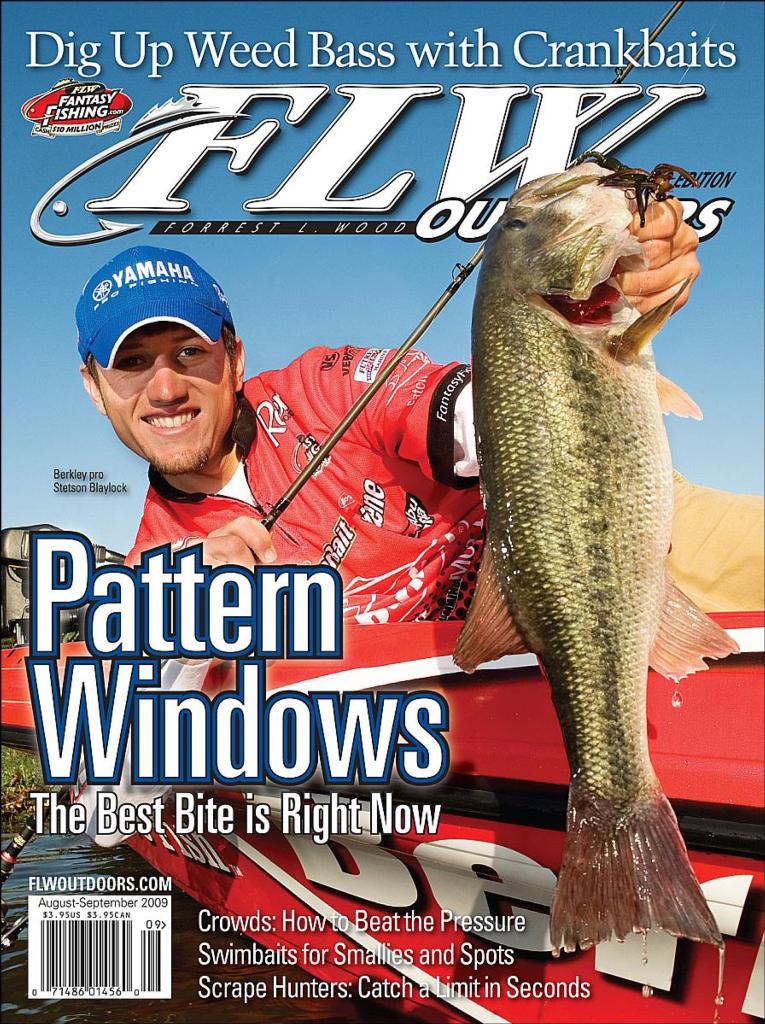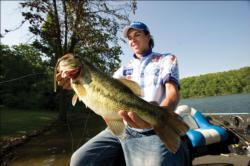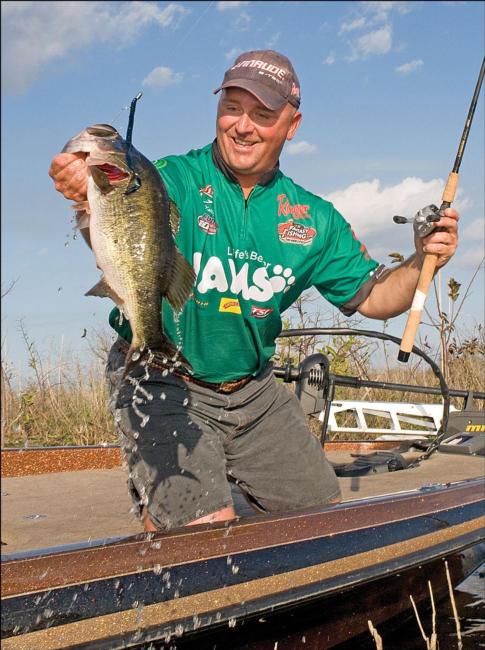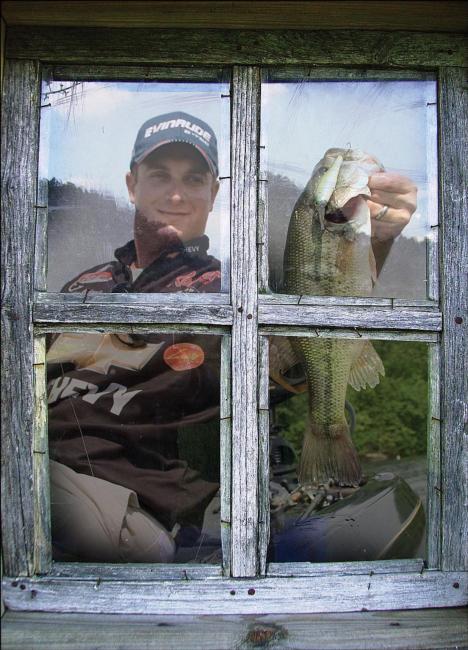Open the window
Having a pattern to yourself means finding one that never existed

————————————–
Editor’s note: This is just one article from a recent issue of FLW Outdoors Magazine, which publishes both a Bass Edition and a Walleye Edition. To learn more about the magazine and how to subscribe, click here.
————————————–
My earliest memories of a TV include a giant “color television set” that took up half of my parents’ living room and weighed as much as a 150-hp outboard motor. That monstrosity of simulated wood grain and glass received a whopping 13 VHF channels. That’s right, 13 channels.
Ironically, the same thing could be said for the way bass anglers described bass fishing patterns back in the days of rabbit-ear antennas, glass tubes and VHF.
Just like the basic television channels, there were only a few bass fishing “patterns.” For instance, the “spawn” generally covered March to May, and the assumption was every bass in a lake was spawning during this time. Then came the “summer pattern,” when, all at once, every bass in the lake moved out to a river ledge. The typical “winter pattern” always involved bundling up in a jumpsuit and snapping a Hopkins Spoon in 50 feet of water.
Fast-forward to 2009. In the modern era of television, many viewers now have cable or a satellite dish pumping more than 200 channels to a flat-screen TV. In fact, entire channels are dedicated to particular interests 24-7, like news, weather, history, fashion, outdoors and even home improvements.
The same thing could be said for the modern era of tournament bass fishing and the way top pros view fishing patterns these days.
Thanks to pros, we no longer just have “the spawn.” We have prespawn, spawn and postspawn subpatterns. Within those subpatterns are even more subpatterns, like cruising fish or fry guarders. Up and down any given lake, an array of patterns and subpatterns is occurring at different stages and times, giving pros hundreds of patterns or “channels” to monitor.
This evolution of subpatterns within patterns has led to a substantial change in the way today’s younger pros approach tournaments.
The traditional approach of going out in practice, finding a secret fishing hole and catching bass from it four days in a row has become as antiquated as 13 VHF channels. There are no secret locations on most reservoirs anymore, and conditions change too much during a nine-day period (from practice to tournament end) to rely on the same location and lure day after day.
These days, big-league pros and local sticks succeed by discovering short-lived miniature subpatterns from day to day. A pattern is good. The best pattern, however, is the hottest pattern at the moment.
On the fly
Secret patterns, at least to top touring pros, come and go by the day.
 “The only secret left in professional bass fishing is to get on a little pattern that no one else knows about because it didn’t even exist two days ago, or yesterday, or even on hour ago,” said 2008 Forrest Wood Cup winner and Febreze pro Michael Bennett of Lincoln, Calif.
“The only secret left in professional bass fishing is to get on a little pattern that no one else knows about because it didn’t even exist two days ago, or yesterday, or even on hour ago,” said 2008 Forrest Wood Cup winner and Febreze pro Michael Bennett of Lincoln, Calif.
Those are some pretty heavy words coming from a 25-year-old. But then again, Bennett did not grow up in an age of VHF channels or rotary-dial telephones connected to a cord. He grew up in the technological age. To him, bass patterns are like wireless text messages: short and brief, constantly coming and going. Where one ends, another begins.
Put another way, he sees fishing, especially tournament fishing, as a series of brief subpatterns that open and close like windows. When one is closing, another is opening somewhere else.
“I’ve never really thought about it that way,” Bennett said. “But it’s incredibly accurate because that’s exactly how I fish. I’m always looking for the next window to open, especially during tournament hours.”
Chevy pro Anthony Gagliardi of Prosperity, S.C., is another young angler who has an inherent understanding of when small pattern windows open and close.
“I know this sounds weird, but I really don’t look for patterns in practice.” Gagliardi said. “I don’t even want to figure the fish out until the tournament actually starts. All I look for is a few bites in an area. And I really don’t even care what lure gets those bites.
“If you practiced with me for four days, you might think I am crazy. You would be stunned at how few fish I actually catch in practice. As soon as I get a few bites in an area, I leave. The excitement in tournament fishing, for me, is to come back to an area where I had a few bites in practice and then figure them out. Spending time dialing into a specific pattern three days before a tournament is a waste because things change so much. Most of the little patterns I find only last a day or two, and then they’re gone.”
The next pattern
There is an old adage in bass fishing: Never leave fish to find fish. Bennett breaks that convention habitually and routinely during practices and tournaments.
“To be competitive at today’s top tournament levels, you have to be able to anticipate which windows are going to open and get in front of them before anyone else does,” he said. “I won two Walmart FLW Tour events last year in that exact fashion. The pattern and water I won those tournaments on I found during the tournament.”
Bennett caught decent limits by noon on the first two days of the Lewis Smith Lake event and the Forrest Wood Cup in 2008 – both events he won – and then invested the rest of each tournament day looking for new water that fit the pattern.
“When I find something in the tournament that was not going on in practice, I really get fired up,” Bennett said. “And that’s exactly what happened at the Forrest Wood Cup. The shallow bite was off all during practice because it was so bright and hot. I practiced deep for three days. On the day off between practice and competition, it rained all day and was very cool.
“The first morning of the tournament, I started shallow with a floating frog and caught a limit pretty quick. I began to realize that something was coming into play that had not been going on at all in practice. In essence, that pattern window was opening, and no one else was on it.”
The second day, Bennett started on a new piece of water he had never fished before and immediately caught a 6-pounder.
“That’s when it all came together,” he said. “I started running new water, caught enough to make the top-10 cut by 11:00 a.m., and then spent the next four hours of that day running Lake Murray looking for new water. I never made a cast, just visually scanned the shoreline looking for the right combination of that temporary pattern: flat banks, shallow grass and docks. When I found those places, I marked them on my GPS.”
On days three and four, Bennett caught $1 million worth of bass off the very water he scouted on day two of the tournament.
“Ideally, that’s the way reading windows is supposed to happen,” he said. “At the Forrest Wood Cup I was fortunate that the pattern window I found stayed open long enough to win. The real challenge is knowing when one window is closing and then switching to one that is opening. You don’t want to get hung out to dry by a closing window.
“At the Walmart FLW Tour event at Table Rock Lake this year that’s what happened to me. I made the top 10, but my window closed much faster than I thought it would. I tried to find some other windows that were opening but couldn’t. Anthony (Gagliardi) got on the window that was opening and won.”
Unfortunately, even the best windows close. The best anglers recognize when it’s time to search for another one to stay on the fish. Take Gagliardi’s win at the Table Rock event. When his primary window closed he detected another one opening that helped him claim the winning check.
Like many pros, Gagliardi had a great first day but began to struggle on the second day. With just two little keepers at noon, he decided to pull off one of his previously productive points in the James River and fish out over 20 to 30 feet of water with a deep-diving suspending jerkbait – there he found the new open window. The fish had moved off the bank and suspended out over points. That discovery allowed him to make the top 10.
Gagliardi’s winning move, however, was to apply his discovery to new water the final two days.
“Once I figured out how the fish were set up over those points in the James, I began to remember a series of points up the White that really fit the bill better,” he said. “On day three, I took a gamble, ran up the White to those points, and the fish were set up the exact same way. It was really neat to anticipate that and then have it happen.”
Weather windows
Sometimes being in front of a pattern window when it opens requires camping out to stake your claim, which is exactly what Iams Smart Puppy pro Koby Kreiger of Okeechobee, Fla., did for a Stren Series Southeast Division victory the first week of March 2004 at Lake Eufaula.
Essentially, in practice, the water temperature was 55 degrees, and the fish were nowhere near spawning. But Kreiger looked at the long-term forecast and could see a big warm-up coming.
“They were calling for low 80s and no wind for all four days of the tournament,” Kreiger said. “I knew what was going to happen, so I went to the lake’s most notorious spawning area where the fish show up first, staked my claim and waited the fish out.”
The place was absolutely dead the first morning of the tournament, but by that afternoon, Kreiger’s first few customers started to funnel into the small spawning pocket. As the window began to crack open, Kreiger caught just four fish for 13 pounds on day one. On day two, his wait paid off as bass poured into the pocket like salmon on a spawning run.
“It was one of the most incredible fishing sights I’ve ever witnessed,” he said. “Hordes of bass came swimming in off the main lake into the place and began making beds right in front of me.”
 For the next two days, Krieger sacked 22 pounds per day and won the tournament by about 7 pounds.
For the next two days, Krieger sacked 22 pounds per day and won the tournament by about 7 pounds.
“If you want to talk about pattern windows opening and closing, consider that a friend of mine, Rodger Beaver (of Dawson, Ga.), was fishing a deep staging spot out in front of that pocket,” Kreiger said. “Rodger caught 20 pounds the first two days of the tournament and was in second place. Then all those fish came to me. His window closed and mine opened, simple as that.”
This is just one example of how weather on a daily and even hourly basis can change conditions and open windows. The best shallow-water bite can be obliterated by a cold front or even by the clouds parting. Meanwhile, a long-term warm-up can move bass shallow, whether it’s from 20 to 12 feet or 12 to 3 feet. Even something as simple as a sunny day turning into a cloudy one can change the bite completely as bass spread out under darker conditions.
Air temperature and sun aren’t the only factors. Rain can raise or lower a lake’s water temperature and change the water level. After or during a rain, consider if it was a “cold” or “warm” rain. Each will affect bass differently.
Even spawns can play out differently due to daily weather changes. Continued warmth after the bass spawn will hold fish longer in the shallows as shad move into skinny water for their own spawn. However, a cold spell will hold the shad out deeper, and the bass will jet from their beds out to deeper holding areas.
While it’s never a bad idea to know what the hot bite is, always keeping an eye on the weather, even well in advance, will pay off in a big way.
Random opportunity
Occasionally, pure chance delivers an opportunity for a pattern window. And when it happens, sometimes the best move is to drop your current pattern and make a change. Other times, it’s the only move. Just ask Andy Morgan of Dayton, Tenn.
“One of the coolest tournaments I ever fished was a Stren Series tournament at Lake Okeechobee,” Morgan said. “During practice, the wind had thrashed South Bay so hard it had stripped every hyacinth from the whole area. There was nothing left to flip down there, and the place was muddy and dead.”
After boxing a limit up north with everyone else on day one of the tournament, Morgan decided to run back down to South Bay and check it one more time.
“Nothing had changed except I found this one tiny place where a little bit of cut-up eelgrass, hydrilla and other weedy junk had floated up against some bulrushes, making a pencil-thin mat about 50 yards long,” he said. “I caught three big ones out of that tiny stretch of floating junk. I couldn’t believe it. Apparently those fish were so desperate for something over their heads they would use anything.”
The next day he returned, and the flotsam mat was gone, but just around the corner, another small batch of shredded vegetation had drifted up against the bulrushes.
“I wrecked them again in that thin line of matted stuff,” Morgan said. “Each morning when I returned to South Bay, the wind had brought in more floating junk that was not there the day before, and the fish set up in it immediately. Everyone had written South Bay off in practice, and since I had it all to myself, I won.”
Floating grass beds, when a dam is pulling current and even boat traffic can open a window to a successful day if an angler is aware enough to see the opportunity. More than likely, other anglers won’t recognize these random patterns, providing the best chance for a “secret spot,” even if it isn’t a spot at all.
Winning a major tournament off a pattern found in the tournament is what makes the best pros the best. They can adjust and react on the fly. Yes, there are still pros who can locate one spot and stick with one lure to fish their way to top finishes. But the consistent pros don’t rely on that happening.
At home or on the tournament trail, don’t get hung up on the banter and rumors of the best patterns from yesterday. Focus on today, and capitalize on pattern windows.
